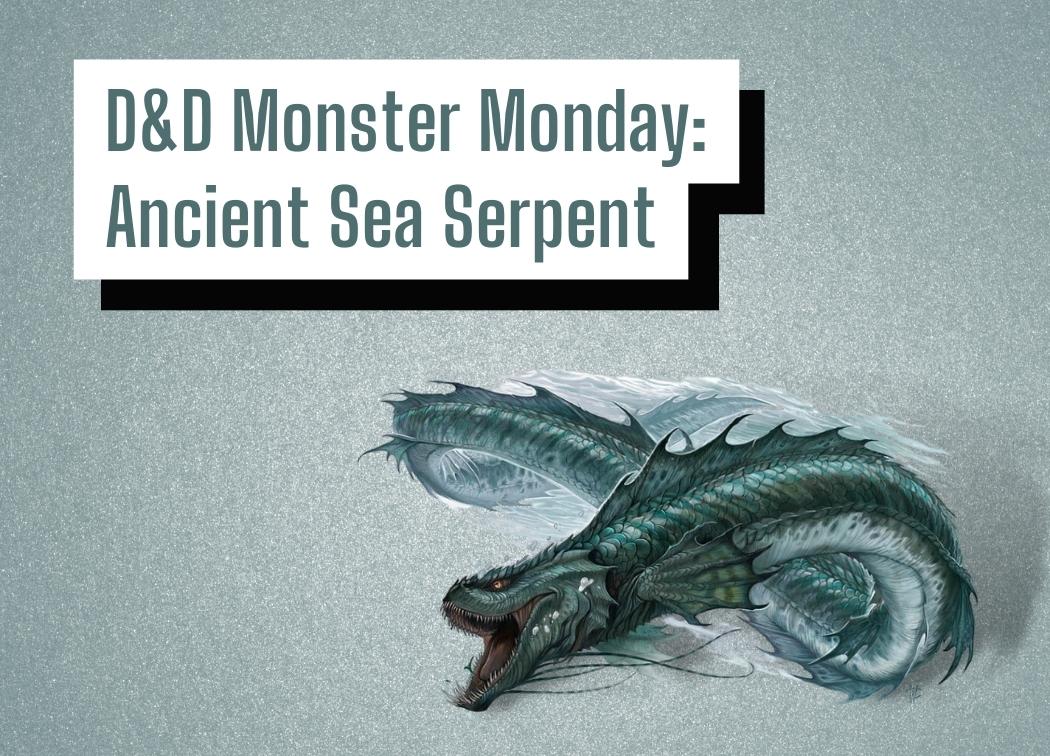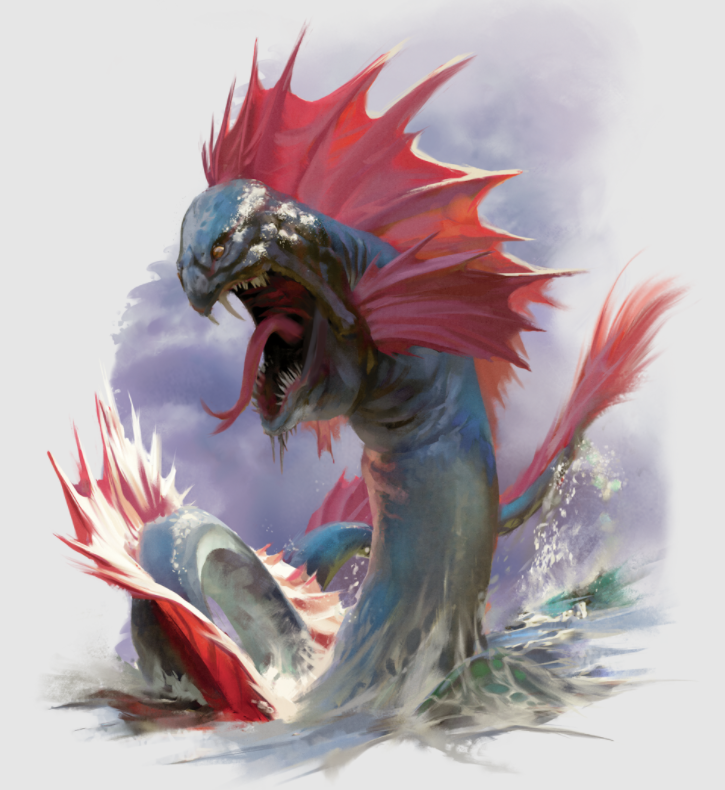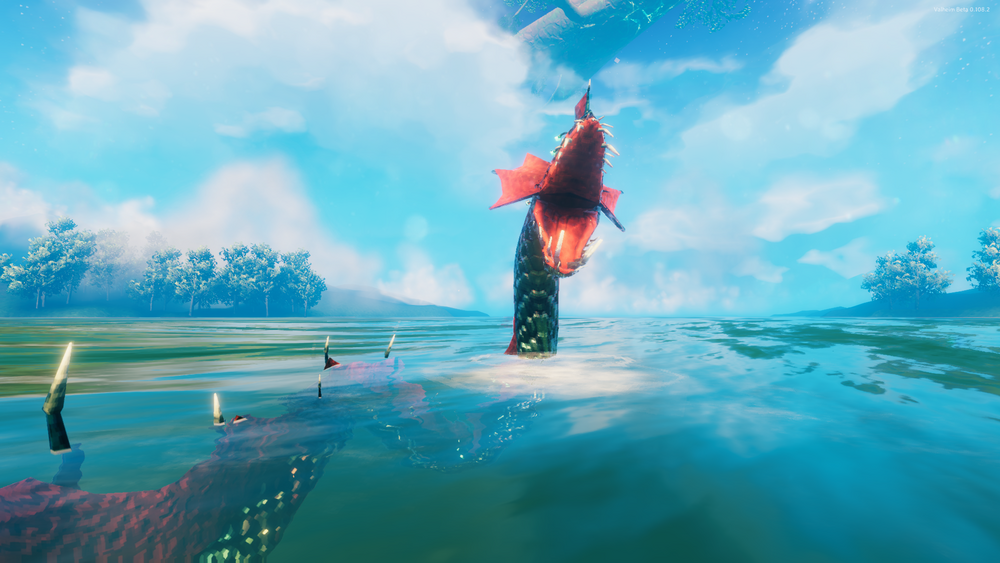D&D Monster Monday: Ancient Sea Serpent

Your ship lurches as out of nowhere, massive waves begin to toss and turn the surrounding waters. You look overboard, desperate to learn the cause of this sudden change of weather. Then you see them. The two, glowing, yellow eyes of a gargantuan, ancient sea serpent.
Ever since our first D&D campaign in college when I tossed a Kraken at the party, they’ve never trusted me on the open waters. I can’t say I blame them though, the open waters in any D&D game can and should be a dangerous place to traverse.
Plenty of monsters live in the depths of the ocean, but I’ve found a shortage of big bastards to throw at an unsuspecting crew. Well, aside from the Kraken, but doing that twice is too cliché. Oh, the dragon turtle too… Ok maybe there’s a decent amount, but sea serpents are so terrifying and fun. It’s a shame we were missing them.
Thankfully, Fizban’s Treasury of Dragons came in clutch with a pairing of sea serpents to use. Because who wouldn’t want to fight a dragon stuck on a flammable wooden vessel in the middle of the ocean without any land in sight?
Well, I wouldn’t, but that’s why I’m the DM and not a player.
So, let’s get our floaties on and mentally prepare ourselves to tread water after an ancient sea serpent tears our ship asunder in today’s D&D Monster Monday!

Ancient Sea Serpent Lore
Their sleek bodies and razor-sharp fins enable them to jet through the water like a missile. Their acute senses let them perceive their prey even in the darkest depths of the sea. A strong tail, adamantine-grade teeth, and bone-chilling breath attack make them fearsome hunters.
Sea serpents are terrifying creatures.
They’re also dragons, so they exhibit a few similar behaviors to their winged cousins. For example, they’re super territorial. If a ship crosses into their land they’ll demolish it without a second thought.
They also love treasure, particularly trade goods and coin that is shipped en-mass around the world’s oceans. Some sea serpents can be bartered with. A chest or two of booty and your ship will be granted safe passage across the serpent’s territory.
They also may instead force you to sacrifice a member of your crew, so make sure you know who’s everyone’s least favorite crew member before you leave port!
Ancient Sea Serpent Stats and Abilities
You can find the ancient sea serpent’s statblock on page 219 of Fizban’s Treasury of Dragons.
Stats
Size: Gargantuan Dragon
AC: 17 (natural armor)
HP: 170 (11d20 + 55)
Speed: 20 ft., swim 60 ft.
STR: 24 (+7)
DEX: 15 (+2)
CON: 20 (+5)
INT: 13 (+1)
WIS: 16 (+3)
CHA: 12 (+1)
The ancient sea serpent is a big snake. It’ll have no issues coiling itself around a ship and snapping it in two with its big snake muscles.
Like most dragons, its scaly hide offers it plenty of protection. 17 AC with a mediocre DEX bonus is quite impressive. 170 HP isn’t too bad for a CR 14 creature either.
You do not want to wind up in the water with one of these creatures though. That 60 ft. of swim speed will swim circles around a typical PC who, unless they have swim speed, will have 15 ft. of movement per turn.
Their ability score spread is quite min-maxed. Strength and Constitution both have phenomenal bonuses enabling the serpent to hit hard and stay in the fight for a few rounds against a capable adventuring party and/or the ship’s cannons.
As a whole their common saving throw abilities are mediocre. Their CON is rock solid at +10 with its saving throw proficiency. The +2 and +3 for DEX and WIS are glaring weak points in their statblock, particularly the DEX bonus.
Resistances, Immunities, Saves, and Skills
Saving Throws: STR +12, CON +10
Skills: Perception +8, Stealth +7
Damage Immunities: Cold
Senses: darkvision 120 ft., passive Perception 18
Languages: Common, Draconic
CR: 14 (11,500 XP)
The two saving proficiencies are nice additions, particularly Constitution’s.
Ancient sea serpents are quite perceptive, even in the dark depths of the ocean. +8 Perception to give them a passive Perception of 18 is super strong when coupled with their 120 ft. of darkvision. Although, this shouldn’t come as a surprise as dragons tend to be very perceptive.
Its high Stealth makes for an interesting encounter opener. Sneaking up on a passing ship and chomping down on the hull makes for a flavorful, yet terrifying random encounter.
Immunity to cold damage is a nice defensive boost due to how common cold damage is in 5e. It makes sense flavor-wise since you’d need to have some resistance to cold when living on the bottom of the sea. Also, keep in mind due to the underwater combat rules, if you keep the serpent in the water (which you should) it’ll also have resistance to fire damage.
I daresay CR 14 may be a bit low. While they have a couple of defensive weak spots, they’re not in a bad place defensively. Their offenses, however, slap hard.
Traits and Abilities
Legendary Resistance (2/Day). If the sea serpent fails a saving throw, it can choose to succeed instead.
Siege Monster. The sea serpent deals double damage to objects and structures.
Legendary Resistance is always a powerful tool. Especially for a creature that has saving throws as a weak point and lacks any condition immunities. It is interesting though that it only has 2 uses of LR per day. I’ve only ever seen 3 as far as I can recall.
Siege Monster is a niche trait for most creatures. It’s either useful for the encounter you designed specifically to use it, or it’s useless when fighting the party outright. However, the ancient sea serpent can make great use of this trait due to its strategic desire to break the party’s vessel and knock them into the sea where it has the upper edge.
Actions
Multiattack. The sea serpent makes one Bite attack and one Constrict or Tail attack.
Bite. Melee Weapon Attack: +12 to hit, reach 15 ft., one target. Hit: 20 (2d12 + 7) piercing damage plus 6 (1d12) cold damage.
Constrict. Melee Weapon Attack: +12 to hit, reach 20 ft., one creature. Hit: 29 (4d10 + 7) bludgeoning damage, and the target is grappled (escape DC 20). Until this grapple ends, the target is restrained, and the sea serpent can’t constrict another target.
Tail. Melee Weapon Attack: +12 to hit, reach 20 ft., one target. Hit: 13 (1d12 + 7) bludgeoning damage. If the target is a creature, it must succeed on a DC 20 Strength saving throw or be pushed up to 30 feet away from the sea serpent and knocked prone.
Rime Breath (Recharge 5–6). The sea serpent exhales a 60-foot cone of cold. Each creature in that area must make a DC 18 Constitution saving throw, taking 49 (9d10) cold damage on a failed save, or half as much damage on a successful one.
As with most dragons, the ancient sea serpent has plenty of offensive options. It has a standard two-attack Multiattack giving it some solid action economy goodness. It always starts with a Bite, but the DM can choose to either Constrict or Tail depending on if you need to push away an attacker or grapple one.
Here’s the average damage breakdown for both options:
Bite & Constrict: 49 piercing & bludgeoning damage
Bite & Tail: 33 piercing & bludgeoning damage
While you’d certainly want to Bite & Constrict every round for maximum damage, the serpent can only have one target grappled at a time. Thankfully, though, that’s not even its best damage option.
Rime Breath, like all dragon breath weapon attacks, is devastating. A 60 ft. cone that deals an average of 49 cold damage per creature is quite the threat. Its 33% recharge rate means that you’ve got a decent shot at blasting this attack a couple of times during an encounter. Plus, its DC 18 CON save makes it quite reliable as well.
Legendary Actions
Tail. The sea serpent makes one Tail attack.
Bite (Costs 2 Actions). The sea serpent makes one Bite attack.
Both of the ancient sea serpent’s legendary actions are just their regular attacks. There are no extra goodies to play with here, unfortunately.
Tail deals below-average damage, but its real strength lies in its potential knockback and knocking a creature prone. Enabling the serpent and its allies to make melee attacks on the prone target with advantage.
Bite feels like a trap to use. You’re only getting an average of 7 more damage per action, yet it costs 2 actions instead of 1. It’s better damage to do 3 Tails per round instead of 1 Tail and 1 Bite. Plus you get some movement displacement to boot.
Ancient Sea Serpent Strengths
Massive Damage
Rime Breath is nutty damage. Plus, your serpent should have no issues getting a ton of value out of it as the 60 ft. cone will cover a solid chunk of space on the deck of a ship. Unless they can fly or swim, the party has a limited area to freely move in combat with one of these creatures making this AoE attack even more devastating.
While you wait for Rime Breath to recharge, your ancient sea serpent will still do a respectable amount of damage per round thanks to their solid Multiattack combos.
Oh, and don’t forget your legendary actions! Your serpent will deal between 33-39 average damage per round depending on what attacks you use.
Plentiful Options
While its damage is fantastic, that’s not even the best part of the ancient sea serpent’s kit. The sheer variety of options at your disposal makes this creature a treat to play.
Tail and Constrict both offer strong crowd control on top of their damage. Tail has a hefty knockback and a solid chance of knocking a target prone unless they have a high Strength save bonus. Constrict restrains a target, hindering their damage output until they break free from the hold which is no easy feat considering it’s a DC 20 escape check.
All three of the creature’s basic attacks offer a 15-20 ft. reach. It’s not surprising given the serpent’s size, but that’s still a ton of range for a creature that has ample maneuverability given its 60 ft. of swim speed.
Plus, the serpent has a nice mid-range AoE in the form of Rime Breath.

A Master of Its Environment
The ancient sea serpent was tailor-made for its environment.
60 ft. of swim speed gives it plentiful movement to position with out in the open waters. Outpacing even the fastest ships in 5e.
120 ft. of darkvision coupled with +8 to Perception checks makes spotting prey or stealthy intruders a cinch, even in the depths of the ocean.
Siege Monster gives an already powerful creature an extra boost in combat. The ancient sea serpent will have no issues sinking any vessel unfortunate enough to cross into its territory. Throwing the brave adventuring party onboard into the frigid open sea.
Ancient Sea Serpent Weaknesses
Susceptible to Certain Saving Throws
The ancient sea serpent’s low Dexterity modifier is a huge issue because it’s the most-used saving throw ability in 5e. Its Wisdom modifier is a little better at +3, but that’s still not great at the tiers 3 and 4 where you’d most likely be seeing this creature.
We also need to take into account the creature’s low Intelligence and Charisma. While they’re not frequently-used ability scores, some deadly high-level spells call for these saves. Mental Prison for example.
While Legendary Resistance is a band-aid fix to this issue, it only has 2 uses per day of it. There’s nothing else to plug up the gaps once Legendary Resistance is expended.
How to Play an Ancient Sea Serpent
Let them Drown!
Underwater combat is super disadvantageous for PCs and creatures that aren’t equipped to properly do so. Unless you’re using a dagger, javelin, shortsword, spear, trident, net, darts, or crossbow, you’ll be attacking at disadvantage.
Submerged creatures also have fire resistance, which means that certain spells will be less effective against the sea serpent if it drags you down into the ocean’s depths or submerges after it attacks.
Oh, and unless you have swim speed, swimming through the water counts as moving through difficult terrain.
So, with all of that in mind, it’s easy to see that the ancient sea serpent wants the party to be thrown overboard, into the ocean. Ergo, it may not be the worst idea to use Siege Monster to your advantage and wreck the ship, significantly hindering the party’s damage output and capabilities once you’ve sunk their vessel.
However, even if you don’t sink the ship, you can still aim to dish-out massive damage to key parts of a ship with Rime Breath.
For example, a serpent’s Rime Breath will have no trouble taking out a galley’s weapon installments since thanks to Siege Monster it’ll do a whopping 98 damage on average.
Keep Rime Breath and Constrict on “Cooldown”
Rime Breath should be used whenever it’s available. It deals phenomenal damage in a wide area. Besides, even if you can’t hit the whole party at once, your serpent will still deal massive damage to the ship.
Using constrict whenever it’s available is your second-highest priority when playing an ancient sea serpent. Grappling and restraining a PC is a great way to weaken the party’s total damage output and boost yours thanks to the restrained condition’s benefits to melee weapon attacks.
Also, constrict enables you to be an evil DM if you drag a grappled target underwater with you. That’s a way more efficient way to entice the party to jump overboard than simply wrecking their ship. You’d have to be a real jerk to not save your drowning friend, right?
5 Ancient Sea Serpent Plot Hooks
- Serpent Stew – The a tavern in the port city’s delicious serpent stew with mushrooms is a highly sought-after meal. Unfortunately, their serpent meat supply is running low. The owner of the tavern is paying a premium for fresh meat.
- Off the Starboard Bow – You were unlucky enough to travel through a sea serpent’s territory. How do you know this? Well, because it’s currently breathing down its icy breath upon half the crew, of course!
- A Dangerous Exchange – You successfully bartered safe passage for you and your crew. Unfortunately, that meant taking on a dangerous request from the serpent. Steal a priceless artifact in a cursed temple on a nearby island and you’ll be given back the unfortunate crew member you left in the serpent’s “care”.
- The Besieged Port – Sea serpent attacks have prevented ships from entering or leaving a massive port city. No one knows what the serpents’ motives are, but the king wants them gone and will pay a premium to whoever does so.
- The Missing Child – The party finds a wounded baby sea serpent washed ashore. Its mother is frantically looking for it and has a vast treasure hoard to compensate the party with.
Conclusions
The ancient sea serpent is a terrifying foe to appear next to your ship in the middle of the ocean. Between its razor-sharp teeth, powerful tail, and bone-chilling breath weapon, you’ve got a creature that can decimate an adventuring party, their crew, and their ship in no time.
Its weakness to certain saving throws is an issue, but given the creature’s mobility and sheer offensive power, it’s still super powerful for its CR.
It’s also got a bunch of fun tools and features baked into its statblock. Siege Monster for example gives you the option to attack the ship directly rather than attacking the party. It creates a unique scenario instead of your typical random encounter while traveling.
I’ve enjoyed Fizban’s Treasury of Dragons as a whole, but the sea serpents stuck out to me as a fun new take on dragons in 5e. There’s a lot you can do with them thanks to how versatile and well-built they are for their environment.

Glad to see you back posting about great monsters!!
I get a lot of great ideas from your posts! But since my group plays Pathfinder 1E, I’m always guesstimating what the stats should be for my games. Have you ever done or would you consider creating a conversion template from D&D 5E to Pathfinder 1E creatures?